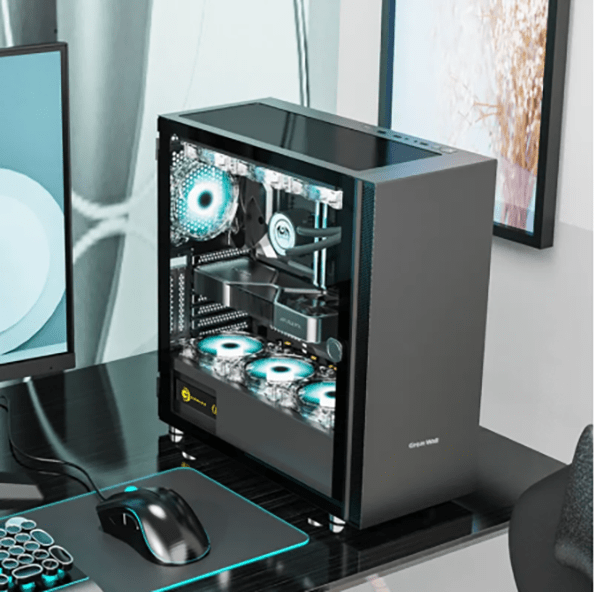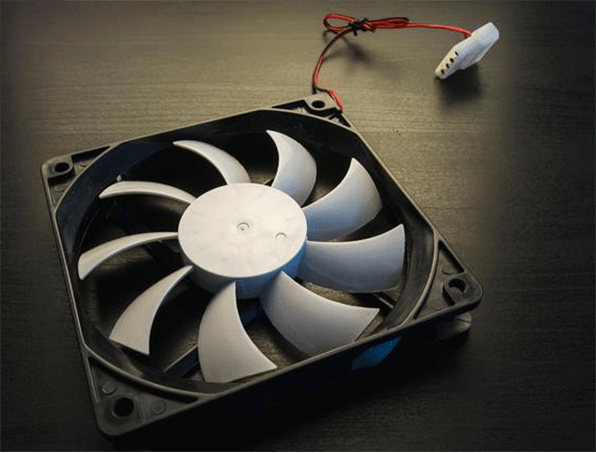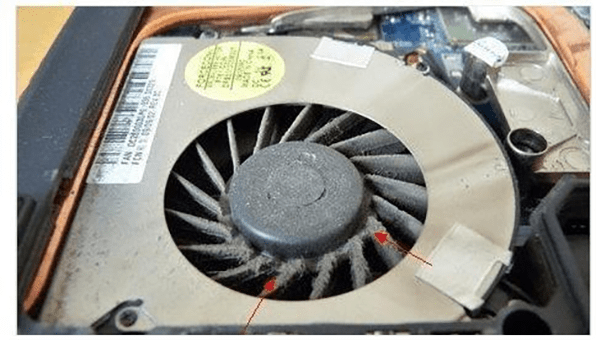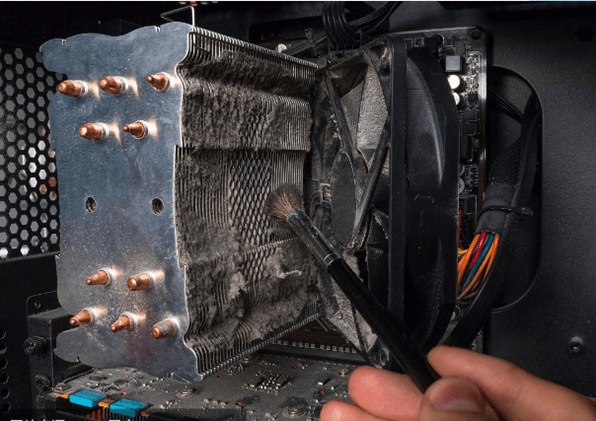
Figure 1: PC cooling fans.
The main sources of heat in a computer are the processor (CPU) and graphics processing unit (GPU). When these components work, they generate a lot of heat. If the cooling system of the computer is not effective enough to dissipate the heat, it will cause the temperature to rise, which will not only affect the stability and performance of the computer, but may also cause hardware damage or even fire and other dangerous situations. To solve the problem of poor computer cooling, you can take the following solutions.
1. 9 Solutions to Keep Your Desktop Computer Cool
The computer cooling is not good, here are some ways to solve the problem:
1.1 Clean the Inside of the Computer Case
Using the computer for a long time will cause dust and dirt to accumulate in various internal components, which will affect the cooling capacity of the computer. Therefore, it is very necessary to clean the computer regularly. Fan blades and radiator surfaces can be gently cleaned with a compressed air duster can or a small brush. Make sure the computer is turned off and unplugged before cleaning.
1.2 Replace the Radiator
If cleaning the dust doesn't solve the heat dissipation problem, the heat sink may need to be replaced. You can choose a larger or a more efficient heat sink, and you need to ensure that the contact surface between the heat sink and the CPU or GPU is smooth.

Figure 2: Heat sink fan.
1.3 Replacing the Cooling Fan
If the cooling fan cannot meet the cooling requirements of the computer, it can be replaced. You can choose a larger cooling fan or a fan with a higher speed to increase the cooling effect.
1.4 Add Cooling Fan
Some computers have only one cooling fan. In this case, you can consider adding one or more cooling fans to enhance the cooling effect of the computer. You can choose a cooling fan installed on the top or side of the computer case, or a cooling fan installed on a radiator.
1.5 Improve the Computer Use Environment
If a computer works in a high temperature and humid environment, it can easily lead to poor heat dissipation. You can change the computer use environment, such as avoiding direct sunlight and maintaining good air circulation. When using the computer, try to avoid blocking the air vents of the computer.

Figure 3: PC case on a desk.
1.6 Reduce Computer Load
If the computer runs under high load for a long time, the heat dissipation of the computer will be insufficient, and the computer load needs to be reduced in time. You can reduce the load by closing unnecessary applications or upgrading hardware.
1.7 Enable Computer Cooling Strategy
Each version of the computer operating system provides some cooling optimization strategies, and you can adjust the cooling strategy of the computer according to your own needs. For example, it can be set to automatically reduce the CPU frequency when the computer load is low, so as to reduce the power consumption and heat generation of the CPU.
1.8 Avoid Excessive Computer Use
Using the computer under high load for a long time may cause overheating. Try to avoid using the computer in a hot environment, and give the computer some rest time regularly to cool down the temperature.
1.9 Apply Cooling Software
Some computer cooling software can help control the temperature of the CPU and the speed of the fans. These software can be used to monitor the temperature of the computer and adjust the fan speed to achieve the best cooling effect.

Figure 4: Computer cooling fan.
2. 5 Solutions to Laptop Overheating
The notebook computer is always hot, and the heat dissipation is not very good. How to solve it. The following summarizes five methods to solve the overheating of the notebook computer.
2.1 Cleaning the Cooling Fans and Air Vents
1. To clean the cooling vents and fans of the notebook, first turn off the notebook, disconnect the power supply and
remove the battery.
2. Then use a screwdriver to unscrew the screws on the rear cover of the notebook and take off the cover.
3. Unscrew the screws fixing the fan, and take out the fan. See the dust accumulated in the picture below, you will
know why the heat dissipation of the notebook is not good, and the computer is very hot. Use tools such as a small
brush to clean the air outlet and fan dust.

Figure 5: Dust on a computer fan.
The internal structure design of different notebooks is different, so be careful when disassembling. If you are not very familiar with computers, it is recommended to send them to the after-sales maintenance point for cleaning to avoid unnecessary damage to other hardware.
2.2 Reapply Thermal Grease to the CPU
Sometimes after cleaning the CPU cooling fan, the CPU temperature has not been significantly improved. It may be that the thermally conductive silicone grease has been used for too long and becomes dry and cracked, which reduces the heat conduction performance. At this time, it is necessary to reapply thermal conductive silicone grease to the CPU. The close contact of the processor and the radiator can fully take away the heat of the CPU.

Figure 6: Add thermal grease for a computer.
2.3 Adjust the Placement of the Notebook
Many friends like to use the notebook on the sofa or bed. Notebooks generally dissipate heat through the bottom, sides, and back. Placing the notebook in these places is not conducive to the heat dissipation. It is best to place the notebook on a wooden desktop or a dedicated computer desk to allow the heat emitted by the notebook to be transferred out.
2.4 Adding Cooling Pad or Cooling Fan
Adding a notebook cooling pad to help the notebook dissipate heat. Generally, the cooling pad is equipped with small
fans that can be driven by a USB power supply, or directly use an external USB small fan to blow the notebook, so as
to achieve the effect of heat dissipation.
A support frame can also be set up under the notebook to suspend the entire computer, and reduce debris near the
notebook, ensuring that the notebook can be naturally ventilated.

Figure 7: Laptop cooling pad.
2.5 Avoid Opening Multiple Programs at Once
Pay attention to running less large-scale programs, or open many programs at one time to increase the CPU load, and
try to develop a habit of cleaning up garbage and useless processes, which can also effectively prevent the computer
temperature from being too high.
Open the system task manager, end unnecessary processes, and reduce CPU load.
3. 8 Solutions to Computer CPU Overheating
Excessively high CPU temperature may lead to problems such as computer performance degradation and system crashes,
which need to be resolved in time. Here are some effective methods:
1. Improve the cooling environment of the computer: The cooling environment of the computer will also affect the
temperature of the CPU. Therefore, you can reduce the CPU temperature by improving the cooling environment of the
computer, such as placing it in a well-ventilated place and using a cooling pad.
2. Clean the radiator: If dust or dirt accumulates on the radiator, it will affect the cooling effect and cause the
CPU temperature to be too high. Radiators can be cleaned with a vacuum cleaner or compressed air.

Figure 8: Clean the heat sink.
3. Replace the radiator: If the radiator is aged or damaged, it needs to be replaced with a new one.
4. Replace the thermal glue: The thermal glue is an important part connecting the CPU and the radiator. If the
cooling glue is aged or fails, the CPU temperature will be too high. The old thermal paste can be replaced with the
professional one.
5. Increase the fan speed: You can increase the fan speed through BIOS settings or third-party software to increase
the cooling effect.
6. Reduce the CPU frequency: You can reduce the CPU frequency through BIOS settings or third-party software to
reduce the CPU workload and lower the temperature.
7. Reduce CPU load: Too high CPU load will also lead to high CPU temperature. Therefore, you can reduce the CPU load
and temperature by closing some unnecessary programs, reducing the game image quality, etc.
8. Replace the CPU: If none of the above methods solve the problem, the CPU may need to be replaced.
Generally speaking, there are many ways to solve the problem of poor heat dissipation of the computer, but the most
important thing is to keep the computer clean and maintain it regularly, so as to avoid the occurrence of poor heat
dissipation.


